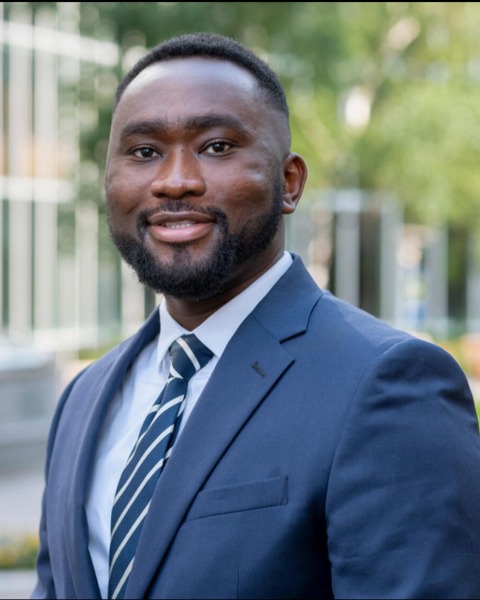Spine
Title: Improvement in Neurological Function After Idiopathic Spinal Cord Herniation Surgery Is Linked to Early Intervention and Absence of Adhesions

Derrick Obiri-Yeboah, MD, MA
Resident
Mayo Clinic Rochester
Rochester, Minnesota, United States
Presenting Author(s)
Introduction: Idiopathic spinal cord herniation (ISCH) is a rare condition wherein the spinal cord is displaced through a dural or arachnoid defect. Diagnosis is often delayed and patients present with chronic myelopathic symptoms that require urgent surgical intervention to minimize permanent neurological deficits. Here, we report on the experience of surgical management of ISCH at a tertiary center.
Methods: Ten patients treated with surgery for ISCH at a single tertiary care center were retrospectively reviewed and data were collected on demographics, time to surgery, myelogram use, intraoperative findings, and postoperative outcomes. Multivariable linear regressions identified predictors of length of stay, neurological improvement, and complications at the p< 0.05 threshold. Results were reported as β-coefficients with 95% confidence intervals.
Results: The median age of our cohort was 67.9 years (37-83); 60% were male. Ventral herniation accounted for 90% of cases with all patients undergoing a posterior surgical approach. The mean time from presentation to surgery was 64.6 days[1-162], and preoperative use of myelograms in addition to MRI was seen in 30% of cases. Arachnoid adhesions observed intraoperatively were associated with a higher complication rate (OR=2.0;95% CI[1.07,3.87];p=0.03). Although not statistically significant, prior spine surgery predicted longer hospital stay (β=4.85 days;95% CI[-2.30,12.01];p=0.15). Symptomatic limb improvement was observed in 50% of cases in the immediate postoperative period, with a negative correlation between earlier surgery and improvement (r=-0.26).Surgical re-exploration was required in 10% of patients due to new or worsening symptoms, with a mean length of stay of 10 days versus 7.2 days (SD=2.3) for non-reexplored patients. Immediate postoperative symptom improvement was seen in 40%,stability in 40% and worsening in 10% of cases.Overall surgical complication rate was 30%, including new neurological deficits in 10%.
Conclusion : Our findings suggest that patient outcomes following surgical management of ISCH are influenced by history of prior spine surgeries, presence of arachnoid adhesions, and time to intervention. Longer recovery times were associated with previous spine surgeries and presence of adhesions which underscore the need for individualized surgical planning and early intervention.
Methods: Ten patients treated with surgery for ISCH at a single tertiary care center were retrospectively reviewed and data were collected on demographics, time to surgery, myelogram use, intraoperative findings, and postoperative outcomes. Multivariable linear regressions identified predictors of length of stay, neurological improvement, and complications at the p< 0.05 threshold. Results were reported as β-coefficients with 95% confidence intervals.
Results: The median age of our cohort was 67.9 years (37-83); 60% were male. Ventral herniation accounted for 90% of cases with all patients undergoing a posterior surgical approach. The mean time from presentation to surgery was 64.6 days[1-162], and preoperative use of myelograms in addition to MRI was seen in 30% of cases. Arachnoid adhesions observed intraoperatively were associated with a higher complication rate (OR=2.0;95% CI[1.07,3.87];p=0.03). Although not statistically significant, prior spine surgery predicted longer hospital stay (β=4.85 days;95% CI[-2.30,12.01];p=0.15). Symptomatic limb improvement was observed in 50% of cases in the immediate postoperative period, with a negative correlation between earlier surgery and improvement (r=-0.26).Surgical re-exploration was required in 10% of patients due to new or worsening symptoms, with a mean length of stay of 10 days versus 7.2 days (SD=2.3) for non-reexplored patients. Immediate postoperative symptom improvement was seen in 40%,stability in 40% and worsening in 10% of cases.Overall surgical complication rate was 30%, including new neurological deficits in 10%.
Conclusion : Our findings suggest that patient outcomes following surgical management of ISCH are influenced by history of prior spine surgeries, presence of arachnoid adhesions, and time to intervention. Longer recovery times were associated with previous spine surgeries and presence of adhesions which underscore the need for individualized surgical planning and early intervention.

.jpg)